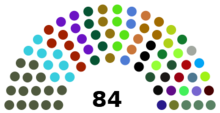Federal Parliament of Brazil
Federal Parliament Parlamento Federal (Portuguese) | |
|---|---|
| 49th Legislature | |
| Type | |
| Type | |
| Houses | Federal Senate Chamber of Deputies |
| History | |
| Founded | May 6, 1826 |
| Leadership | |
Prime Minister | Giovanna Gottschalk, FRETECNA/ROSOB-SC |
President of the Federal Senate | Lauro Wolff, FRETECNA/ROSOB-RS |
President of the Chamber of Deputies | Beatriz Lima, PTB-MG |
| Structure | |
| Seats | 662 members: 84 Senators 578 Federal Deputies |
 | |
 | |
| Elections | |
Federal Senate voting system | Open list proportional representation (D'Hondt method) with a 5% election thereshold |
Chamber of Deputies voting system | Open list proportional representation (D'Hondt method) with a 0.8% election thereshold |
Federal Senate last election | 4 December 2022 |
Chamber of Deputies last election | 4 December 2022 |
Federal Senate next election | 28 June 2026 |
Chamber of Deputies next election | 28 June 2026 |
The Federal Parliament of Brazil (Portuguese: Parlamento Federal do Brasil) is the legislative body of the Brazilian federal government. It has been bicameral since its establishment during the Empire of Brazil, in 1826. The current form of the Federal Parliament was introduced with the promulgation of the 1984 Constitution. It has 662 members: 84 Senators (three from each of the 28 Federative Units) and 578 Federal Deputies (proportional to the state's population, beginning from a minimum of 8 deputies). The 662 members are elected through open-list proportional representation using the D'Hondt method. The thereshold for the Federal Senate is 5%, while the thereshold for the Chamber of Deputies is much lower, at 0.8%. The lower thereshold in the Lower House, allied to the fact that there are 578 seats in the Chamber of Deputies and a huge amount of political parties, resulted in a highly fractionalized democracy, where the only way to govern effectively is through a broad coalition of parties.
The Federal Senate and the Chamber of Deputies represents the 27 States and the Federal District. Each state and the Federal District is represented by three senators, while representation in the Chamber of Deputies is proportional to the population of the federative unit, with a minimum of 8 deputies for the least populated federative units. There is no term limit for either the Federal Senate or the Chamber of Deputies. Members of both house are elected using proportional representation.